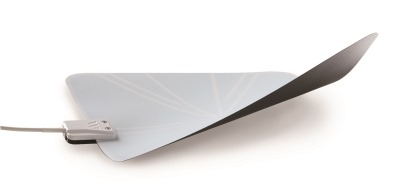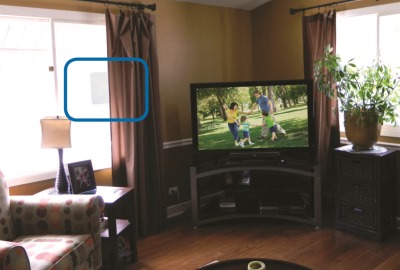Cutting the cord has become a popular phrase for people who are dropping standard pay cable TV and are getting their entertainment content other ways like streaming services or over the air TV. Personally we have Verizon Fios and we get 249 channels and sadly we only watch maybe 10 of those regularly, and actually that’s my kids watching those. I can’t recall the last time I turned the cable box on that’s attached to my HDTV, I get my news from the internet and I have Netflix and Amazon Prime for my main source of entertainment and I also watch the latest shows on the shows webpages. The main way to cut the cord is to get an over the air antenna, but you’ve got many choices when it comes to getting one so how do you know which one to get or how to choose which is right for you? Today I have an interview with Grant Whipple who is the consumer electronics product manager of a company called Winegard that makes antennas for those who want to cut the cord. In the interview we talk about Winegard but also about cutting the cord and about buying an antenna like the types of antennas available and what might be the right antenna for you and your situation. I’ve always been curious about these types of antennas myself so I’ve included questions that I wanted answered which I think are the same as those an average consumer might need to know. Read on to learn more…
Q: Tell us about you? What’s an average day like for you?
Grant Whipple, Consumer Electronics Product Manager.
I develop, manage and distribute our HDTV antennas and wireless product lines. My average day includes working with retail and channel partners on antenna solutions for their customers, and meeting with our engineering team to receive updates on the next great antenna product that they are working on. I offer feedback from a customer perspective to help them design the correct features into the product.
Q: Can you tell us a bit, in your own words, about WineGard? When/Why did the company get started? What’s it all about basically?
Winegard is an amazing company for the fact that it has survived for 60 years in the technology sector. John Winegard started the company when he designed the first broadband, multichannel TV antenna in 1954. Winegard went on to develop all types of antennas and amplifiers for multiple applications such as satellite and medical telemetry, and he was inducted into the Consumer Electronics Hall of Fame in 2005. Through it all we have always built high quality TV antennas right in the United States, and we have developed an unprecedented expertise in antenna design, testing, and manufacturing.
Q: Describe the target consumer or audience for your products?
Our audience for HDTV antennas is anyone who is looking for the strongest value in TV programming today. This ranges from millenials who may be just getting started in the workplace, and are looking cost-effective ways to watch TV to established consumers who simply are not getting enough value out of their TV subscription to justify nearly $90 (or more) each month. Consumers used to be held hostage because an analog TV signal with 5 snowy channels on a 42” flat screen was simply unacceptable; but, now with DTV and multicasting there is so much more content available for free, and the picture is better than any other pay TV service. This is why many people are taking a strong look at cutting the cord.
Q: Is it really feasible to ‘cut the cord’ and just use an antenna? Or is that in combination using the antenna with things like Netflix, Hulu, and Amazon Prime etc?
It is definitely feasible to cut the cord with just an antenna, and many customers are doing it especially if they don’t have internet service or they are on a slower service that doesn’t support streaming well. There is no doubt, though, that when you a pair streaming service for on-demand and catch up TV with an antenna for live and local content that you get the perfect one-two punch that really gives you the feeling of subscribing to pay-TV for a fraction of the price.A good example is this week in TV. I’m watching the Master live in full uncompressed HD glory with my HDTV antenna and when the coverage is over I can watch the last episode of “House of Cards” on Netflix.
Q: Out of all the products you sell, which is your favorite? And why, what makes it your favorite?
Right now my favorite is our FlatWave Air outdoor and attic antenna. It’s such a great value for the price, and it includes a mount and preamplifier in such a small package; yet, it is such a powerful antenna. If you already have coax running through your house you can connect the coax to it, and it has enough amplification to easily provide enough signal to 4 TV tuners so with that one antenna you can provide programming to 4 TVs in your house. It’s also my favorite because you used to have to lug a 10-foot long, 8-foot wide antenna up on your roof to get a decent signal… Now you can just put this 12 x 13 inch square up so your neighbors won’t even notice, and you are getting eye popping HD on all your TVs.
Q: What’s your most popular product?
Our most popular products are the razor-thin FlatWave and FlatWave Amped indoor antennas because they work so well and are incredibly easy-to-install.
Q: What do you feel makes your product unique when compared to others on the market?
I think the 60 years of knowledge in RF reception that we put into our products makes us unique. We feel that our designs truly give the customer the best chance to get the most channels. The other differentiator is that we are privately held company that never left the US to chase profits from cheapening our product. We have a very strong pride in our craftsmanship and care about our customers.
Q: How big of a difference is there between an antenna with an amplifier and one without?
Hans Rabong, a 40-year veteran of Winegard who worked with John Winegard for many years and held thousands of technical training classes on antenna and amplifier installation always told me that ‘1,000 times nothing is nothing when it came to amplification.’An amplifier takes the signal level going into it and preserves the signal down to the tuner. It can’t create more signal. Amplifiers also induce noise into the signal so if you don’t have enough signal to start with they can actually hurt the antenna performance. Coax, connectors and the ATSC tuners in the HDTVs themselves all introduce loss to the incoming TV signal. If the signal is strong enough at the antenna, it can overcome the loss in the coax and connectors and you won’t need an amp. If the signal is weak, an amplifier will help because it will preserve the signal as it travels down the coax and through connectors until it reaches the TV tuner and displays a picture.
Q: In what types of situations would a consumer be better off purchasing an antenna with an amplifier? Without?
An amplified antenna is best for the consumer in three situations: (1) they are in a low signal area, (2)they have a very long run of coax, or (3) they need to distribute the signal to multiple TV through splitters. You can check the DTV signals in your location at http://transition.fcc.gov/mb/engineering/dtvmaps/.
Q: How can a consumer decide whether to purchase an indoor or outdoor antenna? What affects the decision? What should be taken into account when choosing indoor or outdoor?
Signal strength at the location is the main driver for selecting an indoor or outdoor antenna. If you are in a strong signal area you can usually use an indoor antenna to receive signal. As you get farther away from the broadcast towers and the signal gets weaker you may need to mount an outdoor antenna higher up so you will have a better line of site to the broadcast towers. Using a tool like http://transition.fcc.gov/mb/engineering/dtvmaps/ will help you make the decision. Or you can go to the Winegard website for more information.
Q: I’ve always thought it was just better to buy an outdoor antenna as logic says the reception would be better, no walls in the way etc., true or false and why?
This is true for the physics part of things. The outdoor antenna provides fewer obstructions, but it can also be tougher to install, or if you live in an apartment there may be no way to install an antenna outdoors. And for a large part of the population living in a strong signal area an indoor antenna will work great. Another variable for an outdoor antenna is how the long the coax cable run is and how many times you split the signal. If it is very long or is split than you will probably need a preamplifier to overcome thecable and splitter loss.
Q: Is there really much of a difference in signal quality or strength between indoor and outdoor antennas?
It once again depends on the area you live. If you’re closer to the broadcast towers there is enough transmitted power that you won’t notice much difference. In weak signal areas it could be the difference between having enough signal to make a picture or not.
Q: How many channels can the average consumer receive with just an antenna?
It varies from market to market. Smaller markets can receive approximately 15 to 20 channels, and larger metropolitan areas can receive around 80 channels- and the channels selection is continuing to grow.
Q: Do you personally use a WineGard antenna? Why or Why not? If you do, why did you ‘cut the cord’ and do you miss having the few hundred channels of pay cable?
I actually use 3 Winegard antennas: Two Winegard FlatWave over-the-air (OTA) antennas and one Winegard satellite antenna. The first OTA antenna is connected to my satellite set top box. It gives me an amazing HDTV picture for my major networks, and it’s great when the weather gets bad and satellite is unavailable. I obviously also have a Winegard antenna for satellite. The 2nd OTA HDTV antenna is connected to my bedroom TV because I mainly just watch Jimmy Fallon before I go to bed. No need to pay another monthly fee for a STB.
Q: What tips can you offer readers when it comes to purchasing an HDTV antenna?
Try and do your homework on sites like http://transition.fcc.gov/mb/engineering/dtvmaps/ to understand how strong the broadcast signal is in your area, and if you need to receive VHF and UHF signals- or just UHF only. If you are still unsure, you can always try calling a manufacturer to see if they have some suggestions for that area. Don’t fall for antennas that claim incredible 100-mile ranges (there is no way to guarantee that) or antennas that claim to have the highest amplifier gain. TV towers are designed to transmit in about a 60-mile radius on average, and high gain on amplifiers does not mean they will work better.
Q: What makes a good reviewer?
I think a good reviewer is someone who takes all aspects of the product- how it was designed and who will be using it- into account. Not just what their personal use case is.
Q: How have reviews affected your sales?
Reviews are very positive for our sales. We don’t take any shortcuts with our product and that shows in our positive reviews throughout our lineup.
Q: Finally what do you think of sites like technogog (https://technogog.com/ ) that aggregates and analyzes a large number of reviews?
It is great for the consumer to have access to sites like technogog. It really helps a high quality antenna designer and manufacturer like us because sometimes it is tough to show all the little differences that set us apart on our packaging or web page. Showing the reviews all in one spot lets the quality and performance of our product speak for itself.
I’d like to thank Grant Whipple for the interview and the insightful information he provided pertaining to antennas and the tips for purchasing one.
Be sure to visit Winegard to see their full line of over the air antennas: http://www.winegard.com/
As a bonus Winegard sent over an informative infographic all about ‘cutting the cord’:
Infographic sources:
NPD Group https://www.npd.com/wps/portal/npd/us/news/press-releases/pr_120410/
Forbes http://www.forbes.com/sites/amadoudiallo/2013/10/14/cable-tv-price-hikes-unsustainable/
Business Insider http://www.businessinsider.com/cord-cutters-and-the-death-of-tv-2013-11
Verizon Digital Media http://www.verizondigitalmedia.com/content/NewSlides_FULL_FINAL_NOCONJ_v2.pdf
National Association of Broadcasters http://www.nab.org/documents/newsRoom/pressRelease.asp?id=3168
GfK Media & Entertainment http:/.gfk.com/2013/06/confessions-of-a-cord-cutter-skeptic-revisited/
Digital Trends http://www.digitaltrends.com/home-theater/morgan-stanley-report-us-tv-subscribers-to-cut-cord-2014/#!CqGyU
Nielsen – (based on ratings for the week of March 17, 2014) http://www.nielsen.com/us/en/top10s.html





1 comment for “Interview with Grant Whipple of Winegard”